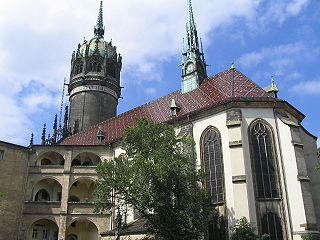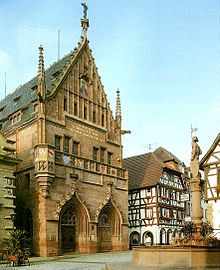
Philip Melanchthon was a German Lutheran reformer, collaborator with Martin Luther, the first systematic theologian of the Protestant Reformation, intellectual leader of the Lutheran Reformation, and an influential designer of educational systems. He stands next to Luther and John Calvin as a reformer, theologian, and moulder of Protestantism.

Wittenberg, is the fourth largest town in Saxony-Anhalt, Germany. Wittenberg is situated on the River Elbe, 60 kilometers (37 mi) north of Leipzig and 90 kilometers (56 mi) south-west of Berlin, and has a population of 46,008 (2018).

Martin Bucer was a German Protestant reformer based in Strasbourg who influenced Lutheran, Calvinist, and Anglican doctrines and practices. Bucer was originally a member of the Dominican Order, but after meeting and being influenced by Martin Luther in 1518 he arranged for his monastic vows to be annulled. He then began to work for the Reformation, with the support of Franz von Sickingen.

Joachim Camerarius, the Elder, was a German classical scholar.

Reformation Day is a Protestant Christian religious holiday celebrated on 31 October, alongside All Hallows' Eve (Halloween) during the triduum of Allhallowtide, in remembrance of the onset of the Reformation.

Hieronymus Wolf was a sixteenth-century German historian and humanist, most famous for introducing a system of Roman historiography that eventually became the standard in works of medieval Greek history.

Protestant Reformers were those theologians whose careers, works and actions brought about the Protestant Reformation of the 16th century.

The Gedächtniskirche der Protestation is a United Protestant church of both Lutheran and Reformed confessions in Speyer, Rhineland-Palatinate, Germany that commemorates the Protestation at Speyer in defense of the evangelical faith, specifically Lutheranism. Built between 1893 and 1904, the church was constructed in memory of the protest that took place at the Diet of Speyer by the Protestant rulers of the Holy Roman Empire in 1529. The tower is the tallest bell tower in the whole Palatinate at 100 metres (330 ft).
Renaissance humanism came much later to Germany and Northern Europe in general than to Italy, and when it did, it encountered some resistance from the scholastic theology which reigned at the universities. Humanism may be dated from the invention of the printing press about 1450. Its flourishing period began at the close of the 15th century and lasted only until about 1520, when it was absorbed by the more popular and powerful religious movement, the Reformation, as Italian humanism was superseded by the papal counter-Reformation. Marked features distinguished the new culture north of the Alps from the culture of the Italians. The university and school played a much more important part than in the South according to Catholic historians. The representatives of the new scholarship were teachers; even Erasmus taught in Cambridge and was on intimate terms with the professors at Basel. During the progress of the movement new universities sprang up, from Basel to Rostock. Again, in Germany, there were no princely patrons of arts and learning to be compared in intelligence and munificence to the Renaissance popes and the Medici. Nor was the new culture here exclusive and aristocratic. It sought the general spread of intelligence, and was active in the development of primary and grammar schools. In fact, when the currents of the Italian Renaissance began to set toward the North, a strong, independent, intellectual current was pushing down from the flourishing schools conducted by the Brethren of the Common Life. In the humanistic movement, the German people was far from being a slavish imitator. It received an impulse from the South, but made its own path.

The 1 November 1954 Stadium is a multi-use stadium in Tizi Ouzou, Algeria. It is used mostly for football matches and is the home ground of JS Kabylie. The stadium holds 20,000 people.

Kings Valley is an unincorporated community and census-designated place in Benton County, Oregon, United States. It is located on the Luckiamute River and Oregon Route 223, the Kings Valley Highway. As of the 2010 census it had a population of 65.

All Saints' Church, commonly referred to as Schlosskirche to distinguish it from the Stadtkirche of St. Mary's – and sometimes known as the Reformation Memorial Church – is a Lutheran church in Wittenberg, Saxony-Anhalt, Germany. It is the site where, according to Philip Melanchthon, the Ninety-five Theses were posted by Martin Luther in 1517, the act that has been called the start of the Protestant Reformation. From 1883 onwards, the church was restored as a memorial site and re-inaugurated on 31 October 1892, 375 years after Luther's posting. Because of its religious significance and testimony to the lasting global effects of the Reformation, the church was inscribed on the UNESCO World Heritage List in 1996 along with other sites in Wittenberg and Eisleben associated with Martin Luther and Philip Melanchthon.
Wietrzno is a village in the administrative district of Gmina Dukla, within Krosno County, Subcarpathian Voivodeship, in south-eastern Poland, close to the border with Slovakia. It lies approximately 5 kilometres (3 mi) north-east of Dukla, 10 km (6 mi) south of Krosno, and 53 km (33 mi) south-west of the regional capital Rzeszów.

Gnesio-Lutherans is a modern name for a theological party in the Lutheran churches, in opposition to the Philippists after the death of Martin Luther and before the Formula of Concord. In their own day they were called Flacians by their opponents and simply Lutherans by themselves. Later Flacian became to mean an adherent of Matthias Flacius' view of original sin, rejected by the Formula of Concord. In a broader meaning, the term Gnesio-Lutheran is associated mostly with the defence of the doctrine of Real Presence.

The Augsburg Confession, also known as the Augustan Confession or the Augustana from its Latin name, Confessio Augustana, is the primary confession of faith of the Lutheran Church and one of the most important documents of the Protestant Reformation. The Augsburg Confession was written in both German and Latin and was presented by a number of German rulers and free-cities at the Diet of Augsburg on 25 June 1530.

Hoher Nistler is a mountain of Baden-Württemberg, Germany.

Tudulinna is a small borough in Ida-Viru County in Alutaguse Parish in northeastern Estonia. It was the administrative centre of the former Tudulinna Parish. As of 2011 Census, the settlement's population was 220.

The Melanchthonhaus is a writer's house museum in the German town of Lutherstadt Wittenberg. It is a Renaissance building with late Gothic arched windows and the broad-tiered gables. It includes the study of the influential Protestant Reformer Philipp Melanchthon, who lived there with his family. In 1954 the house became a museum on Melanchthon's life and work displaying paintings, prints and manuscripts by him and his contemporaries. In 1996, the building became a UNESCO World Heritage Site along with sites associated with Melanchthon's contemporary Martin Luther in Witternberg and Eisleben because of their religious significance and the lasting, global influence of Protestantism.

Kelmė Manor is a former residential manor in Kelmė, Lithuania. Currently it is occupied by Kelmė Regional Museum. Of the nine buildings on the 15.2 hectare estate, three are used for the display of museum artifacts.

Proto-Protestantism, also called pre-Protestantism, refers to individuals and movements that propagated ideas similar to Protestantism before 1517, which historians usually regard as the starting year for the Reformation era. The relationship between medieval sects and Protestantism is an issue that has been debated by historians.
















